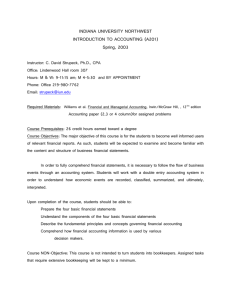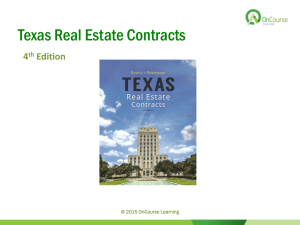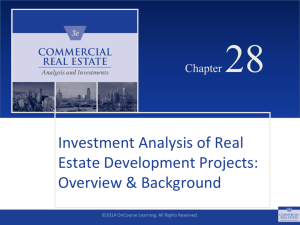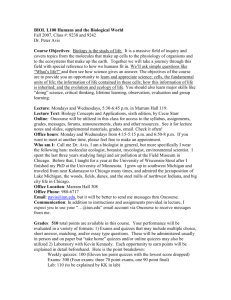Basic Real Estate Appraisal, 9e e_PowerPoint - Ch 06
advertisement
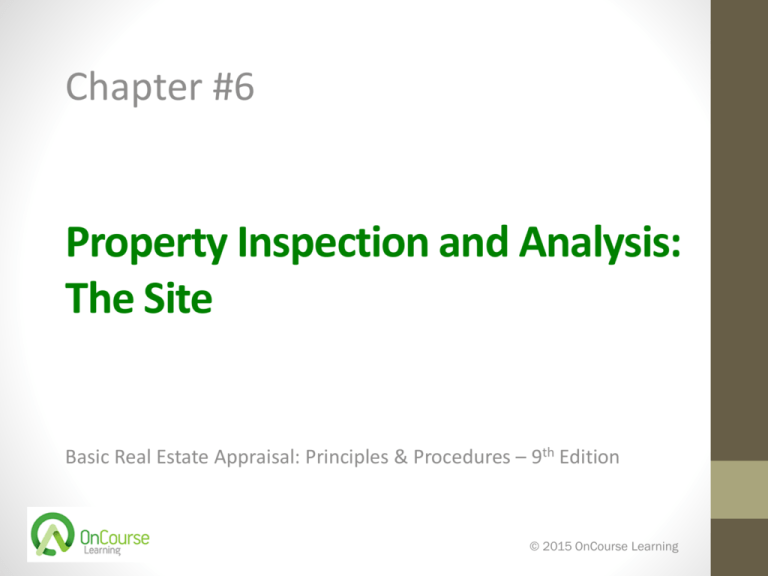
Chapter #6 Property Inspection and Analysis: The Site Basic Real Estate Appraisal: Principles & Procedures – 9th Edition © 2015 OnCourse Learning STUDENT LEARNING OUTCOMES Page 146 • List Three Reasons for making Site Inspections • List Four Criteria for Highest & Best Use • List the Three Main Categories of Site Information • Calculate the Area of a Square, Rectangle, Triangle, Trapezoid & Circle 2 © 2015 OnCourse Learning 6.1 PREPARING TO INSPECT THE SITE Page 147 Reasons for Inspecting the Site • Highest and Best Use Estimate • The land use that will support its highest value (covered in more detail later) • Identify Key Features • Physical Characteristics • Site Location Elements • Public and Private Restrictions • Identify Possible Legal or Physical Problems © 2015 OnCourse Learning 3 Page 148 POSSIBLE LEGAL PROBLEMS • Non-Conforming Use • Encroachment • Unrecorded Easement Notify Client if Undisclosed Problems are Discovered – and Clearly Disclose in the Report © 2015 OnCourse Learning 4 POSSIBLE PHYSICAL PROBLEMS Page 148 • Flood Risks • Poor Soils / Settlement • Environment Hazards Discovered Problems May Change the Scope of Work – and May Require an Expert 5 © 2015 OnCourse Learning WHAT DATA & TOOLS ARE NEEDED? Page 149 • Sales History of Subject • Three Years History Prior to Value Date (USPAP) • Site and Neighborhood Data • Plat Map, Flood map, Aerials, Title Report • Data Sources • Gov’t Websites, FEMA, Zoning • Tools and Equipment • Checklist/URAR, Laptop/Tablet, Measuring Device, Camera, Maps, GPS © 2015 OnCourse Learning 6 SITE DESCRIPTION – URAR FORM Page 152 7 © 2015 OnCourse Learning 6.2 HIGHEST & BEST USE ANALYSIS Page 153 Uniform Standards of Professional Appraisal Practice... • Requires Highest and Best Use Analysis if estimating an opinion of Market Value Alternatively defined as… The reasonable and profitable use that will support the highest land value as of the date of value 8 © 2015 OnCourse Learning HIGHEST & BEST USE ANALYSIS (Con’t.) Page 153 • Purpose – H&B Use helps define the… • Basis of Data Collection • Appraisal Methodology • Alternative Use Assumptions • Highest and Best Use As if Vacant • Highest and Best Use As Improved 9 © 2015 OnCourse Learning Page 155 AS IMPROVED (Example 6.1) 10 © 2015 OnCourse Learning Page 156 INTERIM USE (Example 6.2) The analysis suggests that the residential use (as improved) may be determined to be an Interim Use until commercial land values increase above $350,000 (value as improved). 11 © 2015 OnCourse Learning HIGHEST & BEST USE CRITERIA Page 156 The Four Accepted Tests for H&B Use… • Physically Possible • Legally Permissible • Economically Feasible • Most Productive (Profitable) 12 © 2015 OnCourse Learning 6.3 MAJOR CATEGORIES OF SITE INFORMATION Page 157 • Physical Characteristics • Site Location Elements • Public and Private Restrictions Detailed on the following slides © 2015 OnCourse Learning 13 Page 158 PHYSICAL – SIZE AND SHAPE • Size Usually in Square Feet or Acres • One Acre = 43,560 Square Feet • Assemblage or Plottage • Joining of two or more parcels • May or May Not increase value (Plottage Value) • Gross vs. Useful Area (Net) • Building Footprint or Coverage Ratio • Lot Shape (Width vs. Depth) • Frontage and Excess Depth © 2015 OnCourse Learning 14 PHYSICAL – TOPOGRAPHY Page 160 • Irregular Topography • Hills, Valleys, Ravines, Cliffs, Bluffs and Slopes • May be an Asset – Premium Views • May be a Liability – Higher Utility, Access and/or Development Costs • Orientation to Surrounding Uses. 15 © 2015 OnCourse Learning PHYSICAL – SOIL AND GEOLOGY Page 161 • Soil Stability – Rock vs. Sand • Soils Composition • Ability to absorb moisture • Affect on Septic Systems • Potential Hazards • Slide, Soil Liquefaction or Earthquake 16 © 2015 OnCourse Learning PHYSICAL – DRAINAGE AND FLOOD Page 161 • Appraiser Should Note the Water Drainage Pattern (Run-Off), Signs of Excessive Soil Erosion • Flood Maps/Flood Plain (Hazard Area?) - Is Flood Insurance Required? 17 © 2015 OnCourse Learning PHYSICAL – ENVIRONMENTAL FACTORS Page 161 • Radon and Methane Gas • Hazardous Wastes • Lead Paint • Former Oil Fields • Toxic Wastes 18 © 2015 OnCourse Learning PHYSICAL – FORM OF OWNERSHIP * Page 162 • Conventional Detached Lot • Common Interest Development (CID) • Planned Unit Development (PUD) • Airspace Condominium * This does not mean the legal form of holding title © 2015 OnCourse Learning 19 PHYSICAL – LOT TYPE & ORIENTATION Page 164 Figure 6.8 20 Courtesy of CalBRE © 2015 OnCourse Learning PHYSICAL – ON-SITE & OFF-SITE IMPROVEMENTS Page 167 On-Site Improvements • Earth Leveling, Grading, Fill, Drainage, Compaction or Excavation Off-Site Improvements • Widening and Paving of Streets, Curbs, Gutters, Sidewalks, Alleys, Street Lights and Parking Facilities 21 © 2015 OnCourse Learning ANALYSIS OF SITE LOCATION ELEMENTS Page 168 Evaluation of the Neighborhood • Convenience to Schools, Hospitals and Community Centers • Proximity to Employment and Shopping, and to Medical and Recreation Facilities • Market Appeal of Neighborhood 22 © 2015 OnCourse Learning ANALYSIS OF SITE LOCATION ELEMENTS Page 168 • Proximity to Earthquake, Flood and Environmental Hazards • Comparison with Neighborhood Properties • Utilities (Availability and Reliability) • Transportation 23 © 2015 OnCourse Learning Page 172 PUBLIC RESTRICTIONS • • • • • • • • Regional and Master Plans Zoning Regulations Subdivision Laws Building and Safety Regulations Right of Access Environmental Protection Laws Federal Flood Zones Geological Hazard Zones 24 © 2015 OnCourse Learning Page 174 PROPERTY TAXES • Ad Valorem - “According to Value” • Direct or Special Assessments / Levies • Property Tax Exemptions • Property Transfer Tax 25 © 2015 OnCourse Learning Page 175 PROPERTY TRANSFER TAX Example • Rate of $0.55 per each $500 of new money (Equates to $1.10 per $1,000) • Hence – Tax ÷ 0.0011 = Price • If Stamps are $209.00… $209.00 ÷ 0.0011 = $190,000 26 © 2015 OnCourse Learning Page 176 PRIVATE RESTRICTION • Deed Restrictions • Association Agreements (CC&R’s) • Private Easements • Leases 27 © 2015 OnCourse Learning 6.4 COMPUTING AREA & VOLUME Page 178 Length Length Area of Square = Length X Length (L2) Width Length Area of Rectangle = W X L Example If W = 50’ and L = 100’, what is area of the shape? 50’ X 100’ = 5,000 Square Feet (SF) © 2015 OnCourse Learning 28 COMPUTING AREA & VOLUME (Con’t.) Page 180 • Second Bullet should be 28 29 © 2015 OnCourse Learning Page 185 CHAPTER SUMMARY Site inspection is one of the most important parts of the entire appraisal process. Three major reasons of inspecting the site are: 1. Estimate Highest and Best Use 2. To Identify Key Site Features 3. To Identify Possible Legal and Physical Problems It is desirable to have certain kinds of information before the site inspection begins. 30 © 2015 OnCourse Learning CHAPTER SUMMARY (Con’t.) Page 186 The tools and equipment necessary to perform the inspection were outlined. During the inspection, the appraiser should first investigate the physical characteristics of the site. Physical characteristics also include the form of ownership, type of lot, its orientation, and physical access. The improvements made to the site (on-site) or on areas surrounding it (off-site) must be noted. 31 © 2015 OnCourse Learning IMPORTANT TERMS & CONCEPTS Access Flag Lot Assemblage Frontage Association Agreement Gross Area Building Footprint Highest and Best Use Common Interest Development (CID) Interim Use Condominium Interior Lot Corner Lot Key Lot Coverage Ratio Location Cul-de-sac Lot Lot Shape Depth Lot Type Excess Depth Net Area Page 188 32 © 2015 OnCourse Learning IMPORTANT TERMS & CONCEPTS Off-Site Improvements Right of Access On-Site Improvements T-Intersection Lot Orientation Topography Planned Unit Development (PUD) Townhouse Plottage Transportation Plottage Value Useful Area Private Restrictions Utilities Page 188 Public Restrictions 33 © 2015 OnCourse Learning
